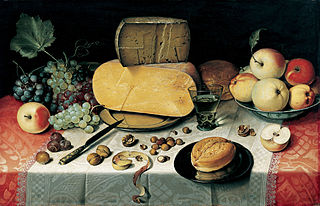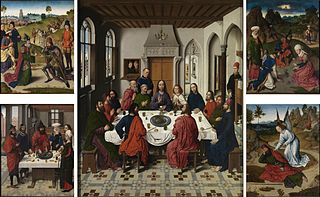
The Eucharist is a Christian rite that is considered a sacrament in most churches, and as an ordinance in others. According to the New Testament, the rite was instituted by Jesus Christ during the Last Supper; giving his disciples bread and wine during a Passover meal, Jesus commanded his disciples to "do this in memory of me" while referring to the bread as "my body" and the cup of wine as "the new covenant in my blood". Through the eucharistic celebration Christians remember both Christ's sacrifice of himself on the cross and his commission of the apostles at the Last Supper.

The Last Supper is the final meal that, in the Gospel accounts, Jesus shared with his apostles in Jerusalem before his crucifixion. The Last Supper is commemorated by Christians especially on Maundy Thursday. The Last Supper provides the scriptural basis for the Eucharist, also known as "Holy Communion" or "The Lord's Supper".

Supper is a meal taken in the evening. It was originally a secondary lighter evening meal. The main meal of the day, called dinner, used to be served closer to what is known as lunchtime, around the middle of the day, but crept later over the centuries, mostly over the course of the 19th century. When it was still at the early time, eating a lighter supper in the evening was very common; indeed it was not always the last meal of the day, as there might be a tea later. Reflecting the typical custom of 17th century elites, Louis XIV dined at noon, with a supper at 10pm. Even when dinner was in the early evening, supper was served at, or on return from, a ball, and might be after other evening excursions. At an English ball in 1791, supper was served to 140 guests at 1:00am.. They would all have had dinner at home many hours earlier, before coming out. Other, grander, balls served supper even later, up to 3:30 am., at a London ball given in 1811 by the Duchess of Bedford.

The Last Supper is a late 15th-century mural painting by Italian artist Leonardo da Vinci housed by the refectory of the Convent of Santa Maria delle Grazie in Milan, Italy. It is one of the Western world's most recognizable paintings.

The Words of Institution are words echoing those of Jesus himself at his Last Supper that, when consecrating bread and wine, Christian Eucharistic liturgies include in a narrative of that event. Eucharistic scholars sometimes refer to them simply as the verba.
"Captain Wedderburn's Courtship" is an old Scottish ballad dating from 1785 or earlier. It is Child Ballad #46, Roud 36. It is known by a number of titles, including "Lord Roslin's Daughter" and "The Laird of Rosslyn's Daughter".

The arrest of Jesus was a pivotal event in Christianity recorded in the canonical Literature. Jesus, a preacher whom Christians believe to be the Son of God, was arrested by the Temple guards of the Sanhedrin in the Garden of Gethsemane. It occurred shortly after the Last Supper, and immediately after the kiss of Judas, which is traditionally said to have been an act of betrayal since Judas made a deal with the chief priests to arrest Jesus. The event ultimately led, in the Gospel accounts, to Jesus' crucifixion.

The Chesterfield Supper Club is an NBC Radio musical variety program (1944–1950), which was also telecast by NBC Television (1948–1950).

The Last Supper is an opera with music by Sir Harrison Birtwistle to an English and Latin libretto by Robin Blaser. Birtwistle composed the music over the period written in 1998-1999. The world premiere was given by the Berlin State Opera on 18 April 2000, with the production directed by Martin Duncan and conducted by Daniel Barenboim. It was subsequently performed by the Glyndebourne Touring Opera in October/November 2000 and the following summer at the 2001 Glyndebourne Festival. Many of the original cast returned for two concert performances at the Piccolo Teatro Studio Expo, Milan and the Teatro Valdocco, Turin on 4-5 September 2008 with the London Sinfonietta, conducted by Elgar Howarth as part of the Settembre Musica festival.

The Sacrament of the Last Supper is a painting by Salvador Dalí. Completed in 1955, after nine months of work, it remains one of his most popular compositions. Since its arrival at the National Gallery of Art in Washington, D.C. in 1955, it replaced Renoir's A Girl with a Watering Can as the most popular piece in the museum.

Church teaching places the origin of the Eucharist in the Last Supper of Jesus with his disciples, at which he is believed to have taken bread and given it to his disciples, telling them to eat of it, because it was his body, and to have taken a cup and given it to his disciples, telling them to drink of it because it was the cup of the covenant in his blood.

Filmworks XXII: The Last Supper is a score by American composer John Zorn for Arno Bouchard's 2009 short science fiction/art film The Last Supper.

Sir Colin John Humphreys, is a British physicist. He is the former Goldsmiths' Professor of Materials Science and a current Director of Research at the University of Cambridge, Professor of Experimental Physics at the Royal Institution in London and a Fellow of Selwyn College, Cambridge. He served as President of the Institute of Materials, Minerals and Mining in 2002 and 2003. His research interests include "all aspects of electron microscopy and analysis, semiconductors, ultra-high temperature aerospace materials and superconductors." Humphreys also "studies the Bible when not pursuing his day-job as a materials scientist."

What It Is is an album by American jazz pianist Mal Waldron recorded in 1981 and released by the Enja label.

The Last Supper of Jesus and the Twelve Apostles has been a popular subject in Christian art, often as part of a cycle showing the Life of Christ. Depictions of the Last Supper in Christian art date back to early Christianity and can be seen in the Catacombs of Rome.

The Last Supper (1630–1631) is an oil painting by Peter Paul Rubens. It was commissioned by Catherine Lescuyer as a commemorative piece for her father. Rubens created it as part of an altarpiece in the Church of St. Rombout (Rumbold) in Mechelen. The painting depicts Jesus and the Apostles during the Last Supper, with Judas dressed in blue turning back towards the viewer and away from the table. Other than Jesus, the most prominent figure is Judas. Judas holds his right hand to his mouth with his eyes avoiding direct contact with the other figures in the painting creating a nervous expression. Jesus is dressed in red and has a yellow halo surrounding his head with his face tilted upwards. Jesus is located centrally in the painting surrounded by his disciples with six on each side, and he holds a loaf of bread with a cup of wine in front of him. Out of all of the figures, he is the most in the light with the figures to the farthest left being the most in shadow. “The scene thus represents a perfect conflation of the theological significance of the Last Supper” meaning the conflation between the blessing of the bread and the wine while still being pivotal in the sense of revealing the betrayal.
The Last Supper Cave, near Denio, Nevada, United States, is an archeological site that is listed on the National Register of Historic Places. It was listed on the National Register in 1975, for its potential to yield information in the future.

The conservation-restoration of Leonardo da Vinci's The Last Supper is an ongoing project that has spanned many centuries. Completed in the late 15th century by the Renaissance artist Leonardo da Vinci, the mural is located in the refectory of the Convent of Santa Maria delle Grazie, Milan, Italy. The Last Supper was commissioned by Ludovico Sforza, Duke of Milan in 1495, as part of a series of renovations to the convent with the intention that the location would become the Sforza family mausoleum. Work began on The Last Supper in 1495 and lasted until 1498. The scene is understood to depict the Bible verse John 13:22, showing the reactions of the Twelve Disciples, at the Last Supper, in the moments following Jesus’s announcement that one among them will betray him.

Altarpiece of the Holy Sacrament or Triptych of the Last Supper is a 1464–1468 dated triptych attributed to Dieric Bouts, now reassembled and held at its location of origin at St. Peter's Church, Leuven.















